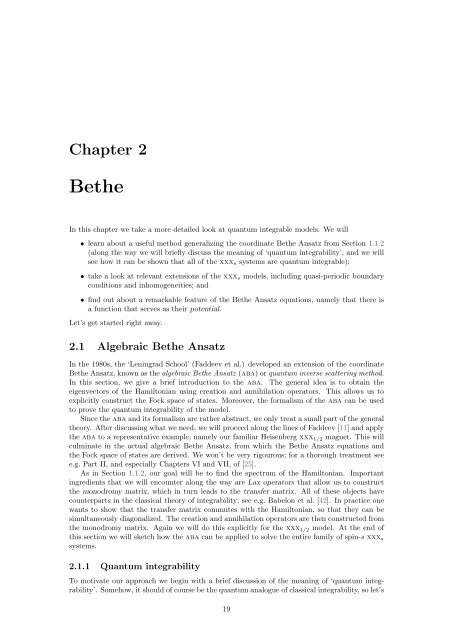The Bethe/Gauge Correspondence
The Bethe/Gauge Correspondence
The Bethe/Gauge Correspondence
Create successful ePaper yourself
Turn your PDF publications into a flip-book with our unique Google optimized e-Paper software.
Chapter 2<strong>Bethe</strong>In this chapter we take a more detailed look at quantum integrable models. We will• learn about a useful method generalizing the coordinate <strong>Bethe</strong> Ansatz from Section 1.1.2(along the way we will briefly discuss the meaning of ‘quantum integrability’, and we willsee how it can be shown that all of the xxx s systems are quantum integrable);• take a look at relevant extensions of the xxx s models, including quasi-periodic boundaryconditions and inhomogeneities; and• find out about a remarkable feature of the <strong>Bethe</strong> Ansatz equations, namely that there isa function that serves as their potential.Let’s get started right away.2.1 Algebraic <strong>Bethe</strong> AnsatzIn the 1980s, the ‘Leningrad School’ (Faddeev et al.) developed an extension of the coordinate<strong>Bethe</strong> Ansatz, known as the algebraic <strong>Bethe</strong> Ansatz (aba) or quantum inverse scattering method.In this section, we give a brief introduction to the aba. <strong>The</strong> general idea is to obtain theeigenvectors of the Hamiltonian using creation and annihilation operators. This allows us toexplicitly construct the Fock space of states. Moreover, the formalism of the aba can be usedto prove the quantum integrability of the model.Since the aba and its formalism are rather abstract, we only treat a small part of the generaltheory. After discussing what we need, we will proceed along the lines of Faddeev [11] and applythe aba to a representative example, namely our familiar Heisenberg xxx 1/2 magnet. This willculminate in the actual algebraic <strong>Bethe</strong> Ansatz, from which the <strong>Bethe</strong> Ansatz equations andthe Fock space of states are derived. We won’t be very rigourous; for a thorough treatment seee.g. Part II, and especially Chapters VI and VII, of [25].As in Section 1.1.2, our goal will be to find the spectrum of the Hamiltonian. Importantingredients that we will encounter along the way are Lax operators that allow us to constructthe monodromy matrix, which in turn leads to the transfer matrix. All of these objects havecounterparts in the classical theory of integrability; see e.g. Babelon et al. [42]. In practice onewants to show that the transfer matrix commutes with the Hamiltonian, so that they can besimultaneously diagonalized. <strong>The</strong> creation and annihilation operators are then constructed fromthe monodromy matrix. Again we will do this explicitly for the xxx 1/2 model. At the end ofthis section we will sketch how the aba can be applied to solve the entire family of spin-s xxx ssystems.2.1.1 Quantum integrabilityTo motivate our approach we begin with a brief discussion of the meaning of ‘quantum integrability’.Somehow, it should of course be the quantum analogue of classical integrability, so let’s19
















